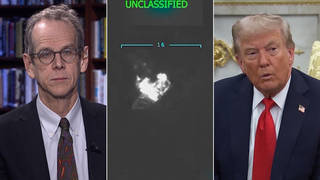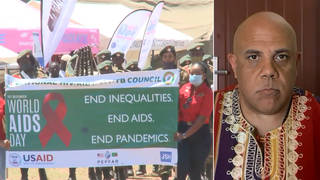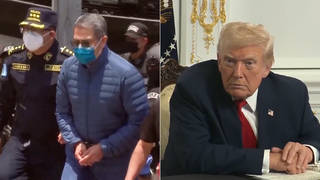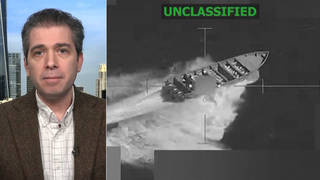
Journalist and author Andrea Pitzer joins us for an extended discussion of current events and her new book, “One Long Night: A Global History of Concentration Camps.”
Transcript
AMY GOODMAN: This is Democracy Now!, democracynow.org, The War and Peace Report. I’m Amy Goodman, with Nermeen Shaikh.
NERMEEN SHAIKH: We turn now to Part 2 of our interview with journalist and author Andrea Pitzer about her new book, which has just been published, titled One Long Night: A Global History of Concentration Camps.
Welcome back to Democracy Now!, Andrea Pitzer. So, you’ve just written this long history, a history—a comprehensive history of concentration camps. Now, many people believe that concentration camps came to an end with the Second World War, but your book, of course, tells a different story. So could you explain what defines a concentration camp and where they exist today?
ANDREA PITZER: Sure. So, a concentration camp, there are a lot of different ideas of them, and so one of the things I tried to do for the book was come up with a real working definition. And for my book, what I chose was the idea of mass civilian detention without trial. And I particularly tried to focus on examples where it also went outside of the legal norms of the place. So, even if it wasn’t a democracy, they had some kind of legal system, so something that went—did an end run around that. And people think, again, that in 1945, that this ended. But really, in some ways, I think the idea of these death camps that had happened were almost a reset button, because then that became what a concentration camp was, and anything less than that somehow then wasn’t a concentration camp, even though there had been decades of other kinds of camps that had had that label before.
So, after World War II, you see sort of two twin phenomena. On the communist state—you have a rise of a number of communist states, and many of them borrow from or combine with local traditions to have Soviet-style gulags. And then, you—also, on the side of democracies, the former allies, you see a lot of colonial-style camps that were similar to the ones that had happened at the turn of the century. So you have the British in Kenya, you have the French in Algeria, you have, eventually, the U.S., the French, you know, in Vietnam, where you are taking a huge number of civilians and relocating them somewhere else and detaining them. And the simplest form of this is a kind of internment. And so, sometimes the lightest versions of these did not have a lot of fatalities, but there’s still a tremendous societal cost. And, of course, then, on the far end, you have rape and torture and mass executions and other things that happen. So, they rarely have a good outcome, and they’re often used against—as they were in the earliest days, against these insurgencies or in rebellions. But they rarely address it without having an even larger cost to the society at whole—as a whole.
And today, where I would say they remain, in the book, I look at Guantánamo, which I don’t think was designed to be that, but the lack of sort of vetting before people were sent there meant that a whole—a large group of people who should never have been even detained very long, in questions with terrorism and their activities with it, were held there long after that they should have been released, because it wasn’t clear who they had that was of value as a detainee and who it wasn’t. And they were more interested in that moment in making sure another attack didn’t happen, so a lot of the normal protections that would happen under international treaties didn’t happen. So that one was sort of one that grew incidentally into a concentration camp, although it was, from the beginning, a real end run around the normal legal system. That’s the whole reason it was put at Guantánamo.
I also look at the Rohingya, because these camps that were set up as what are called IDP camps, internally displaced persons camps, you know, there was a little bit of a refugee camp face on that at the beginning. Their homes had been burned down. And there weren’t just Rohingya that were in some of these camps, although they were segregated. But in the camps where it was non-Rohingya people whose homes had been burned down, they were allowed to come and go at will. And the Rohingya today, still, five years later, cannot come and go at will. And that detention alone starts to vault them into the category of concentration camps. And what we’ve seen, of course, since last October, when some of the first wave of insurgency appeared to be happening, and then, of course, in the last month, where it’s escalated tremendously, is a use of civilian detention camps and cutting off food aid and burning down villages where Rohingya still live, in segregated villages that often have curfews or checkpoints. Those have been destroyed, in many cases, in the northern part of Rakhine state. And so, you have the camps as part of a larger strategy of what you noted that the U.N. human rights commissioner has suggested looks very much like ethnic cleansing. We don’t have all the facts yet, but the reports that are coming out, the satellite views of these burned villages and the reports that we’re getting suggest that this is now part of a larger strategy that is very much in keeping with some of the concentration camp conditions that we’ve seen in the past elsewhere.
AMY GOODMAN: Can you talk, Andrea Pitzer, about how the German concentration camps actually developed? I mean, this is the time of the High Holy Days now. We’re coming out of Charlottesville, where hundreds of young men—they didn’t even feel they needed to cover their faces with sheets, that they were completely exposed, holding torches, saying, “Jews will not replace us.” And you have the anti-fascist demonstrators against them, which goes back, way back, to the time of Germany. Can you talk about how those concentration camps—how Hitler managed to do this?
ANDREA PITZER: Well, I’m glad that you asked about that, because, in the beginning, the Nazi camps didn’t look that different than other camp systems that had already developed, which I think is part of why the world was slow to realize what was going on, because, in fact, the Nazis themselves, in the beginning, didn’t have the potential to implement this Final Solution. It was almost a 10-year process before that happened.
The first camps were set up in Nazi Germany within weeks of Hitler coming to power. Dachau was the first purpose-built camp that was organized and rebuilt and designed to hold thousands of detainees. And the plans to do that happened in the spring of 1933. But in the early days, it was really used—certainly, there were many Jews who were put into the camps, but it was almost a side issue at that point. It was because many of them were politically active against the Nazis, were members of socialist or communist parties. And at first it was a way to really keep power in the country and to get down and get rid of their opposition. They were also used for vagrants. In the mid-’30s, you would see them used to detain Gypsies, which were sometimes kept in kind of segregated camps, even before Hitler came to power. And then you see them used against homosexuals. And certainly Jews went into the camps. And once they were in the camps in those early years, they were treated horribly. They were singled out for persecution. You know, the outcome was very bad.
But it really wasn’t until closer to Kristallnacht, you know, which is near the end of the ’30s, that you see this targeting of Jews in this very specific way. And then, of course, when they realized they could do these mass arrests, they could do all this, and the world would not act, would not take in these refugees, that a lot more options begin to open up for them. And they have this camp system in place, which, by then, of course, was wildly expanded. And so, it was this process that started off not that different than some other camp systems that emerged, but it became quite different.
AMY GOODMAN: Andrea makes a very important point about countries not accepting refugees—among them, the United States. I mean, Anne Frank’s father Otto Frank had applied for visas repeatedly to the U.S., and he couldn’t get in. You had the Voyage of the Damned, hundreds of Jews who were in a ship, and the U.S. would not allow them to dock, and they would ultimately be killed, as they had to move back.
ANDREA PITZER: It’s true. You know, there were some people in the U.S. that were desperately trying to get refugees in. There were some people in Europe who were subverting and flouting all kinds of laws of visas and things to get people out. But the overall sentiment in most countries and in the U.S. was that they did not want these refugees and some of those policy decisions. So sometimes you had different U.S. agencies at opposition with each other. One would be working to bring refugees in, and the other would be stonewalling that. And unfortunately, as we’ve seen across history, it really only takes a small number of people to be dedicated to this harmful goal, and then a larger group of people who are willing to let it happen. And I think the refugee policy during World War II, perhaps the refugee policy today are both examples of that.
AMY GOODMAN: Andrea Pitzer, we want to thank you so much for being with us, journalist and author. Her new book, One Long Night: A Global History of Concentration Camps. If you’d like to hear Part 1 of our conversation, go to democracynow.org. I’m Amy Goodman, with Nermeen Shaikh. Thanks so much for joining us.











Media Options